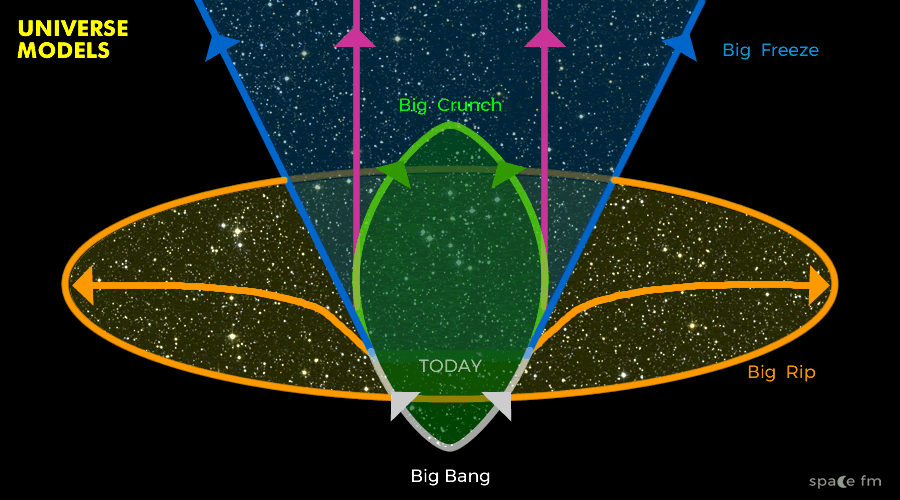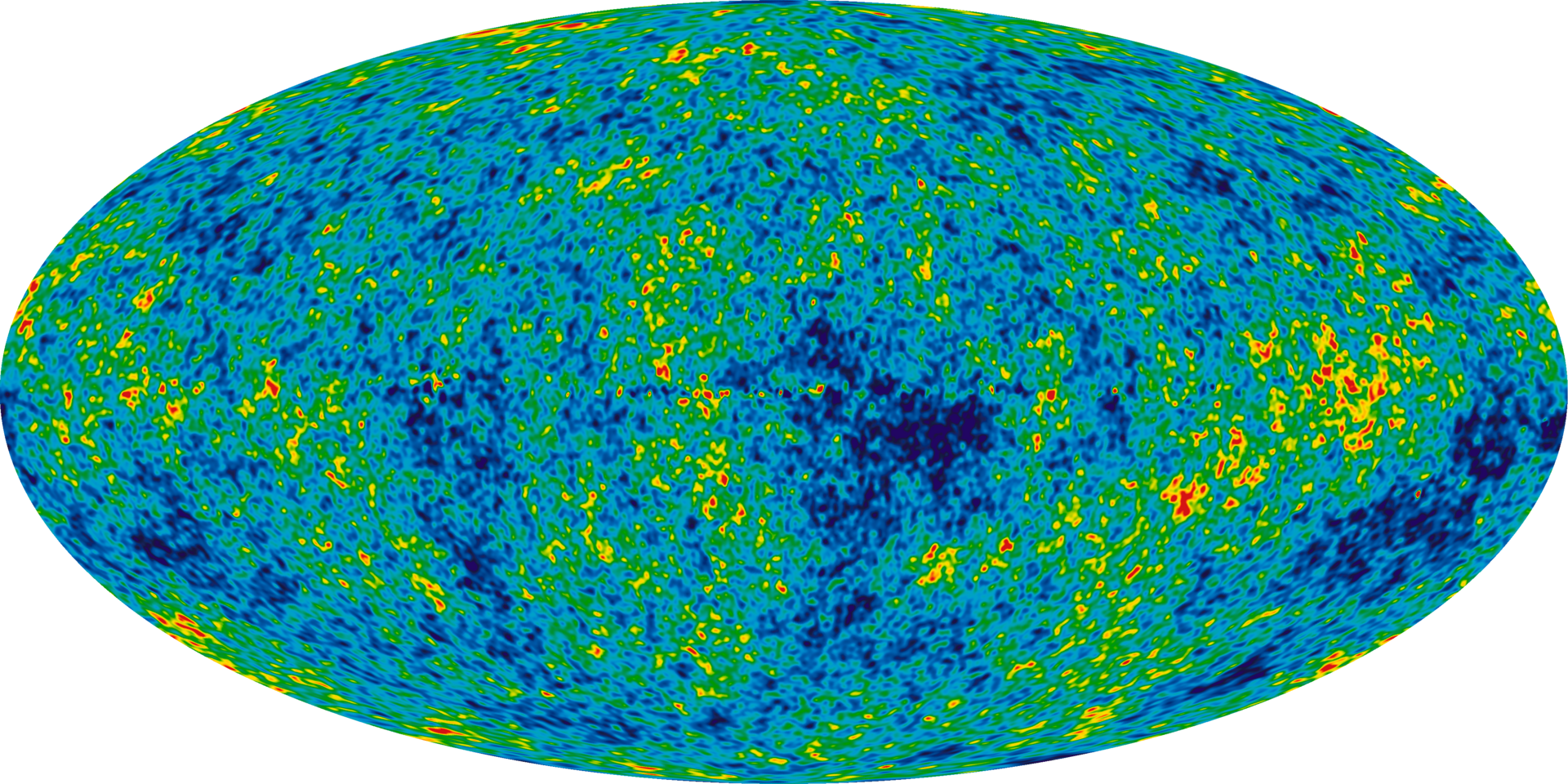In 1929, Edwin Hubble discovered from observations of distant galaxies that the Universe was expanding. This baffled astronomers and the public alike. Then in 1998, another wrinkle: Two different teams of cosmologists found that not only was it expanding, but that expansion was accelerating. This confused them even more since they couldn’t figure out what was driving the acceleration.
They named the mystery component dark energy. Although no one knows what it is, it has some peculiar properties. As far as we know, the density of dark energy is a constant throughout space. That means every cubic meter has the same exact amount of dark energy, and as the universe expands, it creates more. (Don’t worry — total energy is conserved since the expansion of the universe also drives its gravitational energy further into the negatives).

According to our current understanding of cosmology, our Universe’s expansion is gently accelerating. The far right-hand side of the cone shows the currently visible Universe. Photo: NASA/ESA.
How much will the Universe actually expand?
Our uncertainty about the history and future of dark energy allows for three different fates for the Universe. In a future where dark energy density suddenly increases, the Universe will explosively rip itself apart. If, instead, dark energy density drops, then the Universe will reverse its expansion and bounce back upon itself. But according to all our current knowledge, dark energy density will remain constant. The expansion will continue coasting along with the same acceleration. That’s the future we’ll explore in this article.

The different trajectories of the Universe lead to different fates. Photo: space.fm
When last we looked at the future of existence, the Sun had just jettisoned most of its matter into space, destroying the planets and leaving behind its molten core. That’s eight billion years from now. The solar system is more or less gone. But the galaxy is still there, and it has a lot more in store.
150 billion years from now

The Local Group consists of 47 galaxies, of which Andromeda is the largest and the Milky Way the second largest. Photo: Antonio Ciccolella
Where 47 galaxies, including the Milky Way, once orbited one another, a monster now sits. The mega-galaxy comprises over one trillion stars. Since massive blue stars die young, most of the survivors are very small and red. Except in a few pockets where merging galaxies compressed and heated interstellar gas, no new stars have been born for eons.
From almost anywhere in the Local Group, all an observer sees above is a milky-white haze clogging the sky. Because the mega-galaxy’s stars are small and faint, most of them don’t show up as individual pinpricks. Gone are naked-eye constellations, the multicolored nebulae, and the galaxies visible between the stars.

The shadow of the supermassive black hole at the center of the Milky Way. The ring of light comes from photons accelerating toward us from right next to the event horizon. Photo: EHT
And on the edges of the mega-galaxy, the outside universe is dark. The expansion of space has pulled other galaxies so far away from us that the light from their stars will never reach us. Only the photons of the Cosmic Microwave Background, which have traveled toward us since a time when the Universe was on fire everywhere, reach the Local Group from outside.
1 trillion years from now
An unassuming rocky planet orbits a red dwarf, the smallest and dimmest of all true stars. Perhaps it has intelligent life on it. Perhaps they build a telescope, and look up at the sky.
In one direction, the starry mist of the Local Group mega-galaxy blocks out all. A few nearby points of light stand out of the morass. The people on this planet know that their star is not alone, and they search for life around other stars just as we search today.
In the other direction is blackness. It is absolute. The expansion of space has stretched the wavelengths of Cosmic Microwave Background photons past the size of the observable universe. They wash over the telescopes on that insignificant planet, but they’re not really light in the same way that the current of a river is not an ocean wave. They carry no information.

This famous map of the Cosmic Microwave Background is deceptive. In fact, the visual differences are magnified by ten thousand times their actual strength. Photo: WMAP/NASA
Among the information they don’t carry is evidence of the Big Bang. Because the Cosmic Microwave Background is identical in every direction, and light would never have enough time to travel between all of the locations on its surface, all of those locations must once have been very close together.
It’s possible that the observers would be able to determine the density of dark energy from the trajectories of stars ejected from the mega-galaxy. If so, they could make the leap to an expanding Universe and the possibility that somewhere out there, farther than they can see, are others like them.
100 trillion years from now
The era of star formation is at an end. There is no longer any gas left between stars to give rise to new ones, and no massive stars to replenish it via explosive supernovae. In fact, there are very few stars at all.
When stars run out of fuel to burn, they form one of three remnants. White dwarfs are the lightest, comprised mostly of helium or carbon and oxygen. Then there are neutron stars, which are so dense that they’re able to compress protons and electrons into a crystal lattice made of neutrons. And finally, there are black holes. For the most part, these are the objects which now make up the mega-galaxy.
Every so often in this stellar graveyard, though, something new flickers into life. Floating among their massive counterparts are the ruins of stars that never made it in the first place. More like solitary Jupiters than our Sun, brown dwarfs don’t burn hydrogen and are only visible up close. When two of these brown dwarfs collide, they create a real star.
Most of the galaxy is still dead, but not all.

The Rimmer system, left, consists of two brown dwarfs, one more massive than the other. It’s only 30 light-years away. Photo: DESI/Legacy Survey
100 sextillion years from now
All galaxies have disintegrated. Sooner or later, their constituent components either ventured too near the central supermassive black hole or rocketed off into space.
Now, a white dwarf sits in a vacuum. It doesn’t drift. There is nothing else in its visible universe relative to which it might drift. Dark energy has ripped apart everything not bound by internuclear forces.
If ever this white dwarf had a planet, it absorbed it long ago. Now it sits, and perhaps it spins gently. And, ever so slowly, it evaporates. Its protons may undergo a theorized decay process. If they don’t, random quantum flukes allow the structure of the white dwarf to rearrange itself on unimaginably long timescales.
Either way, the white dwarf jettisons photons and other particles. Space expands between them, and they vanish over the horizon of the visible universe.
1 nonillion years from now
The supermassive black hole that used to lurk at the center of the Milky Way is a lot more supermassive now. It has subsumed every other black hole, every brown dwarf, planet, and stellar remnant that didn’t escape the mega-galaxy.
Counterintuitively, black holes aren’t perfectly cold. They have a faint temperature arising from a bizarre quantum mechanical effect. Pairs of photons pop into and out of existence all the time without anyone noticing, like the background static of existence. Then, a fraction of a second later, they annihilate one another.
Sometimes, virtual photons pop into existence right outside the event horizon of a black hole. Since the photons have slightly different directions, it’s possible for one of them to cross the event horizon, never to be seen again. That leaves the other one free to sail off into the wide, wide world.
So black holes emit light, and anything that emits light loses energy. Slowly, very slowly, this unfathomable black hole is evaporating.
10106 years from now
All the black holes are gone, and the universe consists of a very diffuse particle soup. Electrons and photons bubble in a weak gas. Collision by collision, they exchange energy with one another. When two people hold hands, their skin approaches the same temperature. The same is happening for the Universe.
We don’t know what that temperature is, and anyway, it’s irrelevant. Differences in temperature drive physical processes, like hot steam against cold air in the dry pipe of a train. When everything is the same temperature, nothing will ever happen again.
Two electrons collide, and their energies edge toward one another just a little bit more.
Nowhere and nowhen
The Universe exists. It is made up of photons and electrons and a handful of more obscure particles. All of them have the same energy. Everything is the same in every direction. In many ways, everything has always been the same.
That’s because time is defined by the direction of increasing sameness. If you fill a salt shaker with pepper on the top and salt on the bottom and then let it roll down the hill, it will show up at the bottom as a nice salt-and-pepper mix. In this case, gravity speeds up a more universal process. This measurement of sameness is called entropy, and it’s always increasing. That’s what makes today different from tomorrow.
Now, there is no tomorrow. There’s just today, on and on and on.






